|
The Ozone Hole 2021
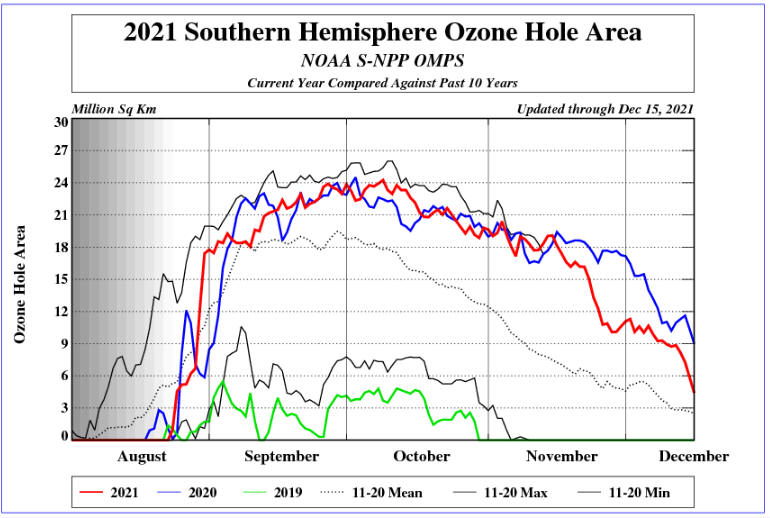
Climate Prediction Center - Stratosphere: SBUV-2 Total Ozone - Ozone
Hole (noaa.gov)
Antarctic ozone hole is 13th largest on record and expected
to persist into November
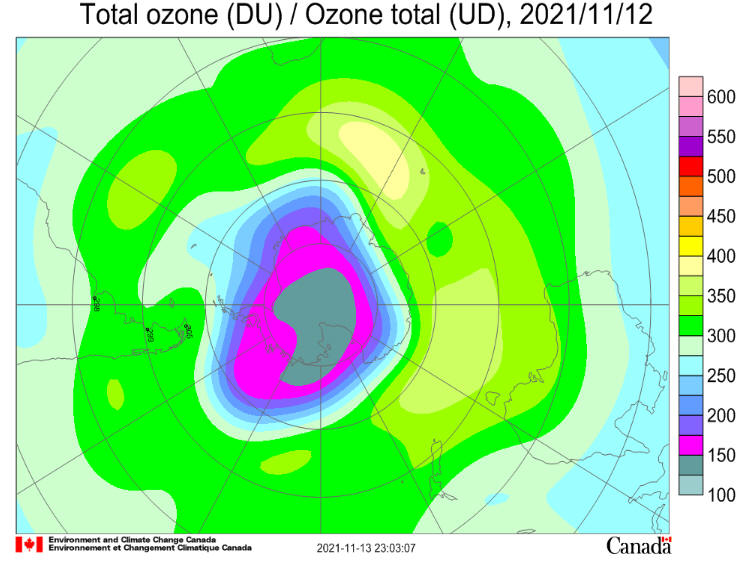
Antarctic ozone
today: Ozone amounts over the continent are beginning to
recover, but remain very low. The 2021 ozone hole grew rapidly from
late August and peaked
at around 24 million
square kilometres (msqkm) in early October, above the average of the
last decade, though comparable to last year. It has now shrunk
a little to 18 msqkm. Lowest ozone values are currently around
110 DU. Higher ozone values are seen around the continent just
outside the southern polar vortex, particularly south of Australia
where values are near 400 DU. The polar vortex peaked at
around 35 msqkm in late September, above average for the time of
year. It has now shrunk a little to 32 msqkm, much larger
than average. The Antarctic stratosphere currently remains
fairly stable. The temperature of the ozone layer over
Antarctica is rising but is still below the -78°C
Polar Stratospheric Cloud (PSC) formation threshold in the lower
parts of the ozone layer at the vortex centre, as warming propagates
downwards. It is generally below the long term average.
The area with PSCs reached a maximum of around 29 million
square kilometres (msqkm) in early August, above the average of 25
msqkm. It has shrunk to near zero, reaching this point
later than average over the last decade. The ozone layer
temperature is highest around Antarctica and declines towards the
equator and towards the centre of the polar vortex. An
extensive ozone hole is expected to continue over the coming ten
days.
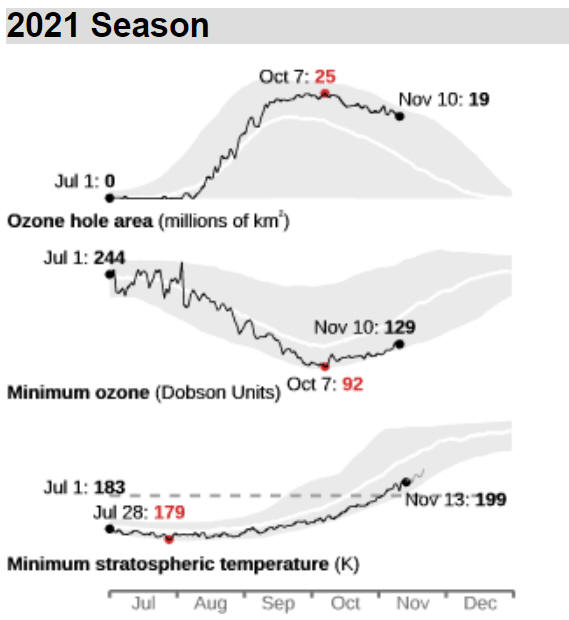
NASA Ozone Watch: Latest
status of ozone
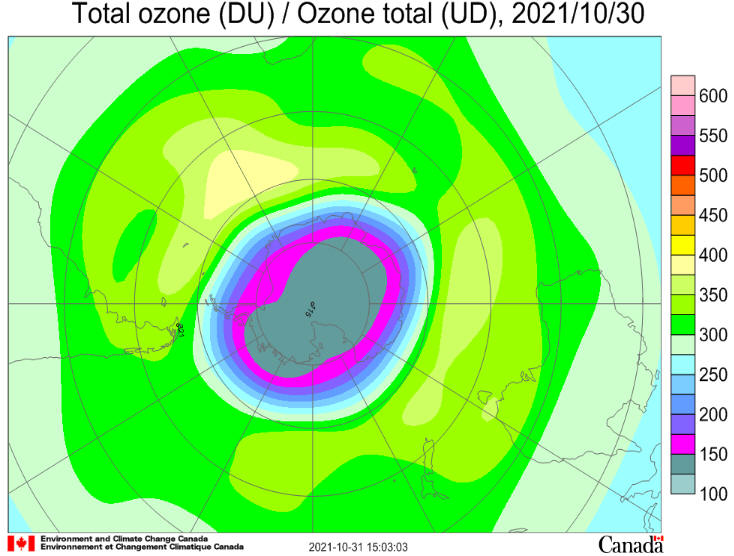
October 27, 2021 NASA
The 2021
Antarctic ozone hole reached its maximum area on October 7 and ranks
as the 13th largest since 1979. Scientists from NASA and NOAA
reported that this year’s ozone hole developed similarly to last
year’s: A colder than usual Southern Hemisphere winter led to a deep
and larger-than-average ozone hole that will likely persist into
November or December.
“This is a large ozone hole because of the
colder-than-average 2021 stratospheric conditions, and without a
Montreal Protocol, it would have been much larger,” said Paul
Newman, chief scientist for Earth sciences at NASA’s Goddard Space
Flight Center.
What we call the “ozone hole” is a thinning of the ozone
layer in the stratosphere above Antarctica that develops every
September. Chemically active forms of chlorine and bromine—derived
from human-produced compounds—are released into the stratosphere
during reactions on high-altitude polar clouds. The reactive
chlorine and bromine then initiate ozone-destroying reactions as the
Sun rises in the Antarctic at the end of winter.
NASA and NOAA monitor the ozone hole via complementary
instrumental methods. NASA’s Aura satellite, the NASA-NOAA Suomi NPP
satellite, and NOAA’s JPSS NOAA-20 satellite all measure ozone from
space. Aura’s Microwave Limb Sounder also estimates levels of
ozone-destroying chlorine.
This year, NASA satellite observations determined the ozone
hole reached a maximum of 24.8 million square kilometers (9.6
million square miles)—roughly the size of North America—before
beginning to shrink in mid-October. Colder-than-average temperatures
and strong winds in the stratosphere circling Antarctica contributed
to its size.
In addition to the ozone hole’s area, scientists also track
the average amount of depletion—how little ozone is left inside the
hole. NOAA scientists at the South Pole Station record the layer’s
thickness by releasing weather balloons carrying ozonesondes and by
making ground-based measurements with a Dobson spectrophotometer.
On
October 7, 2021, scientists recorded a total-column ozone
concentration of 102 Dobson units, the 8th-lowest level since 1986.
Prior to the emergence of the ozone hole in the 1970s, average ozone
above the South Pole in September and October ranged from 250 to 350
Dobson units.
While the 2021 Antarctic ozone hole is larger than average, it is
substantially smaller than those in the late 1990s and early 2000s.
The chart above shows the average size of the ozone hole (solid blue
and gray lines), as well as the range of its size (light blue and
gray shaded bar) for each year since 1979.
The ozone hole is recovering due to the Montreal Protocol and
subsequent amendments banning the release of harmful ozone-depleting
chemicals called chlorofluorocarbons, or CFCs. Newman and colleagues
estimated that if atmospheric chlorine levels from CFCs were as high
today as they were in the early 2000s, this year’s ozone hole would
have been larger by about four million square kilometers (1.5
million square miles) under the same weather conditions.
NASA Earth Observatory images by Joshua
Stevens, using data courtesy of Paul Newman and Eric Nash/NASA/Ozone
Watch, and GEOS-5 data from the Global
Modeling and Assimilation Office at NASA GSFC. Story by Sofie
Bates/NASA’s Earth Science News Team, adapted for NASA Earth
Observatory by Kathryn
Hansen.
Substantial Antarctic Ozone Hole in 2021 (nasa.gov)
Antarctic ozone hole is 13th largest on record and expected to
persist into November | National Oceanic and Atmospheric
Administration (noaa.gov)
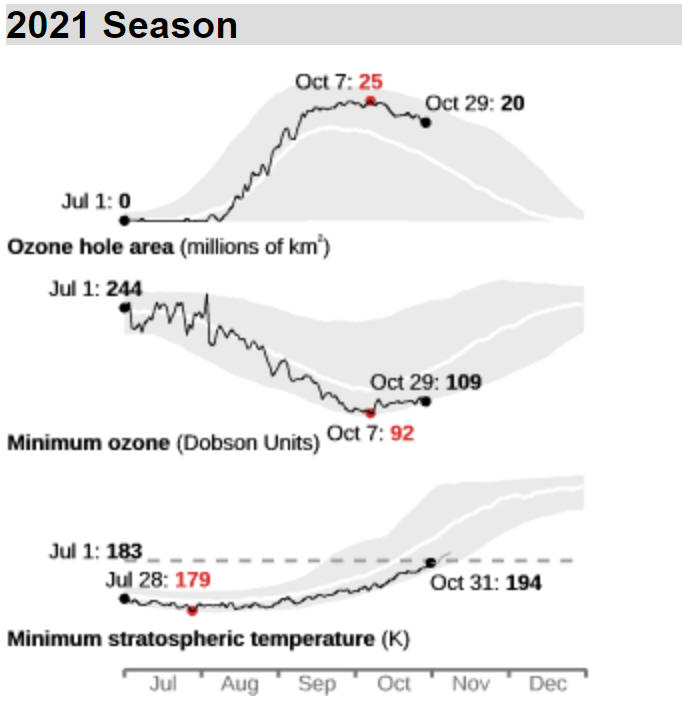
NASA Ozone Watch: Latest
status of ozone
Antarctic ozone today: Ozone amounts
over the continent remain near their minimum, but are beginning to
recover. The 2021 ozone hole grew rapidly from late August and peaked
at around 24 million square kilometres (msqkm)
in early October, above the average of the last decade, though
comparable to last year. It has now shrunk a little to 21
msqkm. Lowest ozone values are currently around 110 DU.
Higher ozone values are seen around the continent just outside the
southern polar vortex, particularly south of Australia where values
are over 400 DU. The polar vortex peaked at around 35 msqkm in
late September, above average for the time of year. It has
now shrunk a little to 34 msqkm. The Antarctic stratosphere
currently remains fairly stable. The temperature of the ozone
layer over Antarctica is rising but is still generally below the -78°C
Polar Stratospheric Cloud (PSC) formation threshold, except at the
higher levels, as warming propagates downwards. It is
generally below the long term average. The area with PSCs
reached a maximum of around 29 million square
kilometres (msqkm) in early August, above the average of 25 msqkm.
It has shrunk to 10 msqkm, above average for the time of year.
The ozone layer temperature is highest around Antarctica and
declines towards the equator and towards the centre of the polar
vortex. An extensive ozone hole is expected to continue over
the coming ten days.
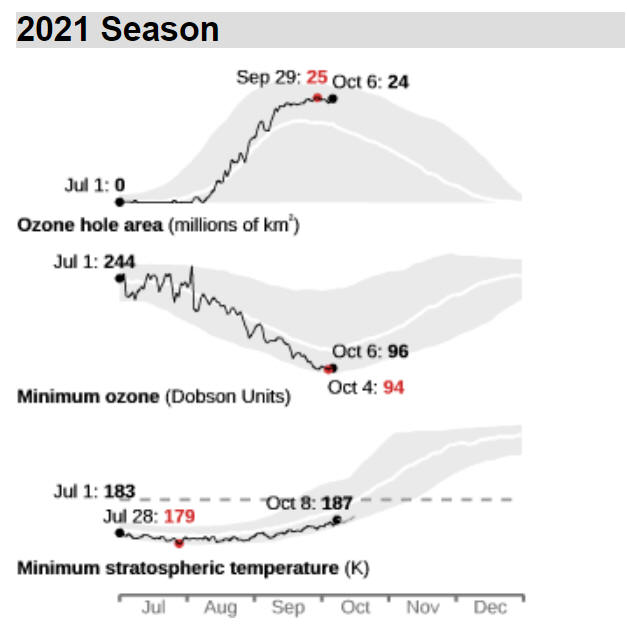
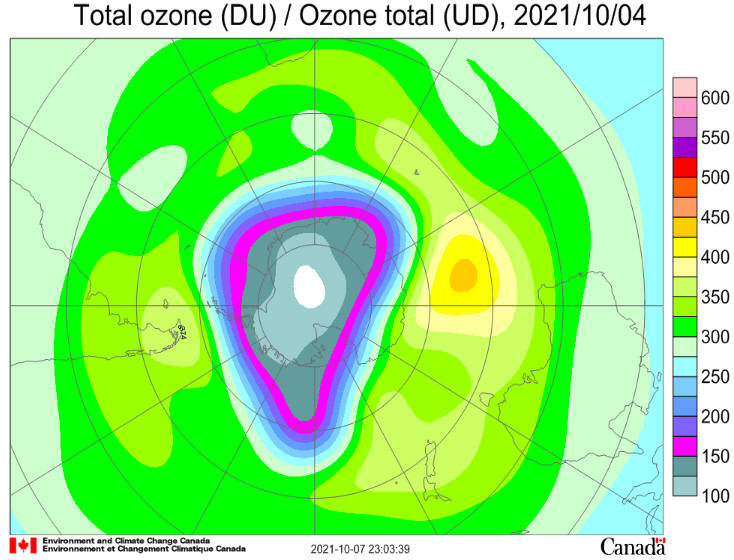
Antarctic ozone today: Ozone amounts over
the continent are near their minimum. The 2021 ozone hole grew
rapidly from late August and now
covers around 23 million square kilometres
(msqkm), above the average of the last decade, though comparable to
last year. Lowest ozone values are currently below 100 DU.
Higher ozone values are seen around the continent just outside the
southern polar vortex, particularly south of Australia where values
are over 400 DU. The polar vortex is near its maximum size, at
around 35 msqkm, above average for the time of year. The
Antarctic stratosphere currently remains fairly stable. The
temperature of the ozone layer over Antarctica has passed the winter
minimum but is still widely below the -78°C
Polar Stratospheric Cloud (PSC) formation threshold. It is
generally below the long term average. The area with PSCs
reached a maximum of around 29 million square
kilometres (msqkm) in early August, above the average of 25 msqkm.
It has shrunk to 15 msqkm, above average for the time of year.
The ozone layer temperature is highest around Antarctica and
declines towards the equator and towards the centre of the polar
vortex. Ozone depletion is expected to continue over the
coming ten days, with the ozone hole returning to a more circular
form, although offset from the Pole towards the Atlantic.
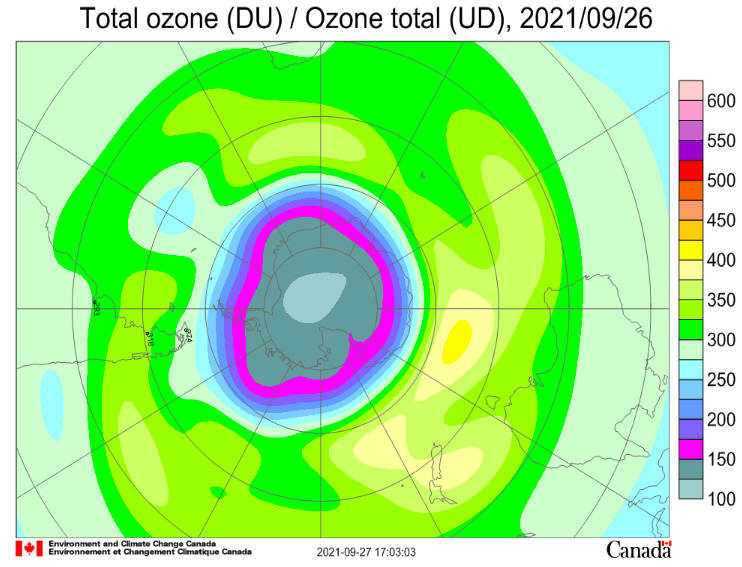
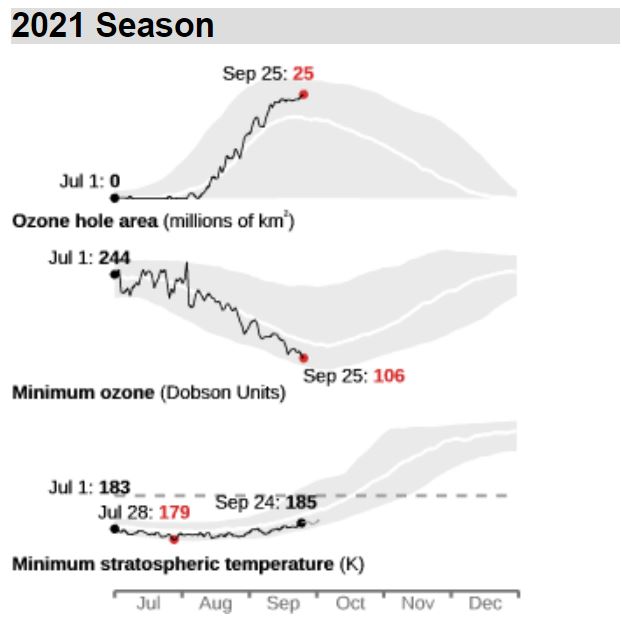
NASA Ozone Watch: Latest
status of ozone
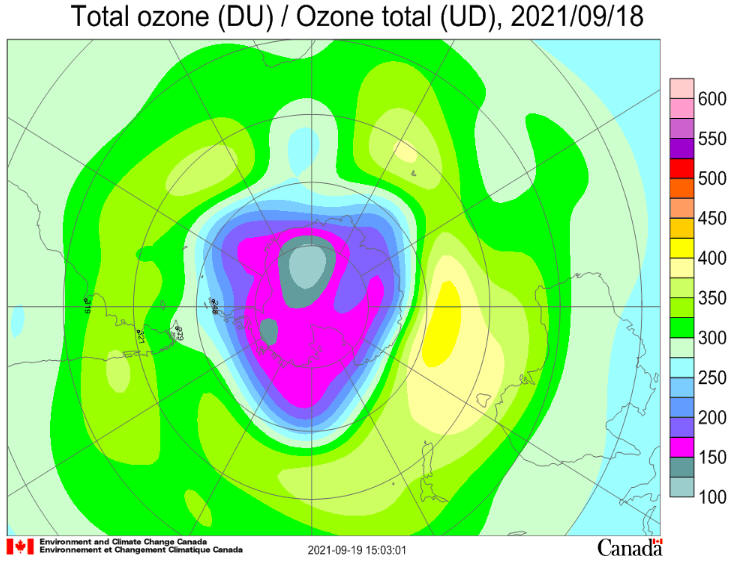
16th September 2021
Following the discovery of the Antarctic ozone hole in the 1980s,
and the resultant international protocols established to reduce the
destruction of ozone, the International
Day for the Preservation of the Ozone Layer is now marked each
year on 16 September to maintain awareness of the human impact on
our environment. Dominating the headlines since its discovery was
announced in 1985, this ‘ozone hole’ has been carefully monitored
every austral spring ever since. The Copernicus Atmosphere
Monitoring Service (CAMS)* monitors ozone in the atmosphere, as well
as ultraviolet radiation that gets through the ozone layer to reach
Earth’s surface. The Service records past trends, gives a snapshot
of the current situation and forecasts ozone concentrations over the
next days to support research, policy monitoring and information of
the public. Each year as the Southern Hemisphere heads into spring,
human-made chemicals break down ozone over the Antarctic, causing
the ozone layer to become much thinner. Because the ozone hole can
be located over regions with populations at risk of being exposed to
unhealthy levels of UV radiation, the information that CAMS provides
– based on satellite and in situ observations and detailed models of
the atmosphere – is therefore very important.
This year’s ozone hole
CAMS constantly monitors
Earth’s ozone layer,
tracking the formation and evolution of the annual chemical
destruction of ozone that leads to the development of the hole. CAMS
scientists have been closely monitoring the development of this
year´s ozone hole over the South Pole, which has now reached an
extent larger than Antarctica. After a rather standard start, the
2021 ozone hole has considerably grown in the last two weeks and is
now larger than 75 % of ozone holes at that stage in the season
since 1979.
This year, the ozone hole developed as expected at the start of the
season. It seems pretty similar to last year's, which also wasn't
really exceptional until early September, but then turned into one
of the largest and longest-lasting ozone holes in our data record
later in the season. Now our forecasts show that this year´s hole
has evolved into a rather larger than usual one. The vortex is quite
stable and the stratospheric temperatures are even lower than last
year, so it may continue to grow slightly over the next two or three
weeks.”
Copernicus is the European Union's Earth Observation Programme,
looking at our planet and its environment for the ultimate benefit
of all European citizens.
Monitoring ozone for a healthier world | Copernicus
Antarctic ozone today: Ozone amounts over the
continent are declining as ozone depletion intensifies and ozone hole
levels have been reached. The 2021 ozone hole has grown
rapidly and covers
around 21 million square kilometres (msqkm), above the
average of the last decade. Lowest ozone values are currently around
160 DU. Higher ozone values are seen around the continent just
outside the southern polar vortex, particularly south of New Zealand where
values are over 400 DU. The polar vortex is near its maximum size,
at around 33 msqkm, a little above average for the time of year.
The Antarctic stratosphere currently remains fairly stable. The
temperature of the ozone layer over Antarctica has passed the winter
minimum but is still widely below the -78°C
Polar Stratospheric Cloud (PSC) formation threshold. It is generally
below the long term average. The area with PSCs reached a maximum of
around 29 million square kilometres (msqkm) in early
August, above the average of 25 msqkm. It has shrunk to 20
msqkm, a little above average for the time of year. The ozone layer
temperature is highest around Antarctica and declines towards the equator
and towards the centre of the polar vortex. Ozone depletion is
expected to increase over the coming weeks.
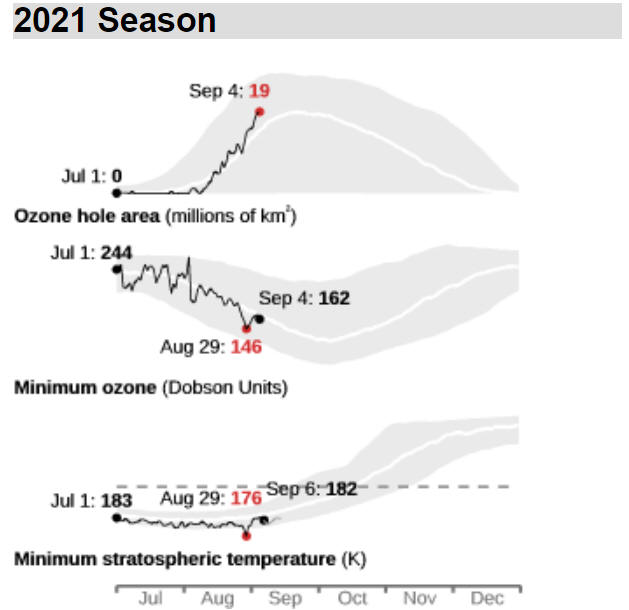
Antarctic ozone today: Ozone amounts over the
continent are declining as ozone depletion intensifies and ozone hole
levels have been reached. The 2021 ozone hole is growing
rapidly and covers
around 19 million square kilometres (msqkm), above the
average of the last decade. Lowest ozone values are currently around
140 DU above the continent south of Africa. Higher ozone values are
seen around the continent just outside the southern polar vortex,
particularly over the Indian Ocean sector where values are near 430 DU.
The polar vortex is near its maximum size, at around 33 msqkm, a little
above average for the time of year. The Antarctic stratosphere
currently remains fairly stable. The temperature of the ozone layer
over Antarctica is near the winter minimum and is widely below the -78°C
Polar Stratospheric Cloud (PSC) formation threshold. It is generally
below the long term average. The area with PSCs reached a maximum of
around 29 million square kilometres (msqkm) in early
August, above the average of 25 msqkm. It has shrunk to 23
msqkm, a little above average for the time of year. The ozone layer
temperature is highest around Antarctica and declines towards the equator
and towards the centre of the polar vortex. Ozone depletion is
expected to increase over the coming weeks.
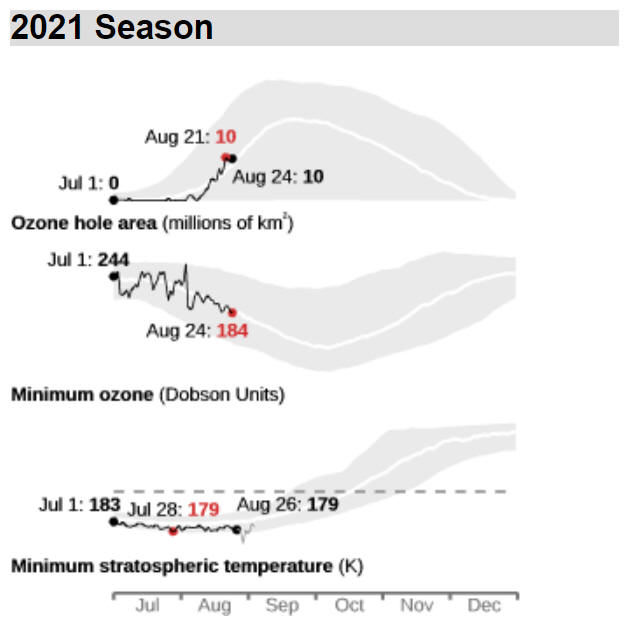
NASA Ozone Watch: Latest
status of ozone
Antarctic ozone
today: Ozone amounts over the continent are declining as ozone
depletion intensifies and ozone hole levels have been reached. The
2021 ozone hole has begun to grow and covers
around 1 million
square kilometres (msqkm). Lowest ozone values are currently around
190 DU near the base of the Antarctic Peninsula. Higher ozone
values, over 400 DU are seen around the continent just outside the
southern polar vortex, particularly over the Indian Ocean sector.
The polar vortex is near its maximum size, at around 32 msqkm, a little
above average for the time of year. The Antarctic stratosphere
currently remains fairly stable. The temperature of the ozone layer
over Antarctica is near the winter minimum and is widely below the -78°C
Polar Stratospheric Cloud (PSC) formation threshold. It is generally
below the long term average. The area with PSCs reached a maximum of
around 29 million
square kilometres (msqkm) in early August, above the average of 25 msqkm.
It has shrunk to 25 msqkm, a little above average for the time of year.
The ozone layer temperature is highest around Antarctica and declines
towards the equator and towards the centre of the polar vortex.
Ozone depletion is expected to increase over the coming weeks.
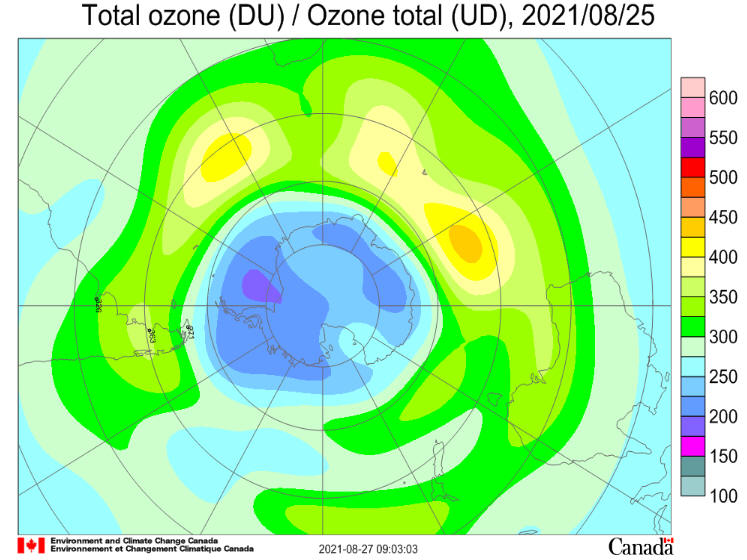
Antarctic ozone
today: The 2021 southern polar vortex is still building, so that
higher ozone values, over 400 DU are seen around the continent. The
stratosphere is currently fairly stable. Ozone amounts over the
continent are beginning to decline as ozone depletion commences.
Lowest ozone values are currently around 220 DU and are relatively low and
uniform across the continent. The temperature of the ozone layer
over Antarctica is near the winter minimum and is widely below the -78°C
Polar Stratospheric Cloud (PSC) formation threshold. It is generally
below the long term average. The area with PSCs reached a maximum of
around 29 million square kilometres (msqkm) in early
August, above the average of 25 msqkm. It has shrunk to 26
msqkm, a little above average for the time of year. The ozone layer
temperature is highest around Antarctica and declines towards the equator
and towards the centre of the polar vortex. The vortex has grown to
32 msqkm, a little above average for the time of year. Ozone
depletion is expected to increase over the coming weeks.
Antarctic ozone today: The 2021 southern polar
vortex is building, so that higher ozone values, up to 390 DU are seen
around the continent. The stratosphere is currently very stable.
Ozone amounts over the continent are beginning to decline as ozone
depletion commences. Lowest ozone values are currently around 240 DU
and are relatively uniform across the continent. The temperature of
the ozone layer over Antarctica is still falling and is widely below the -78°C
Polar Stratospheric Cloud (PSC) formation threshold. It is generally
below the long term average. The area with PSCs is 28 million
square kilometres (msqkm), above average for the time of year. The
ozone layer temperature is highest around Antarctica and declines towards
the equator and towards the centre of the polar vortex. The vortex
has grown to 29 msqkm, a little above average for the time of year.
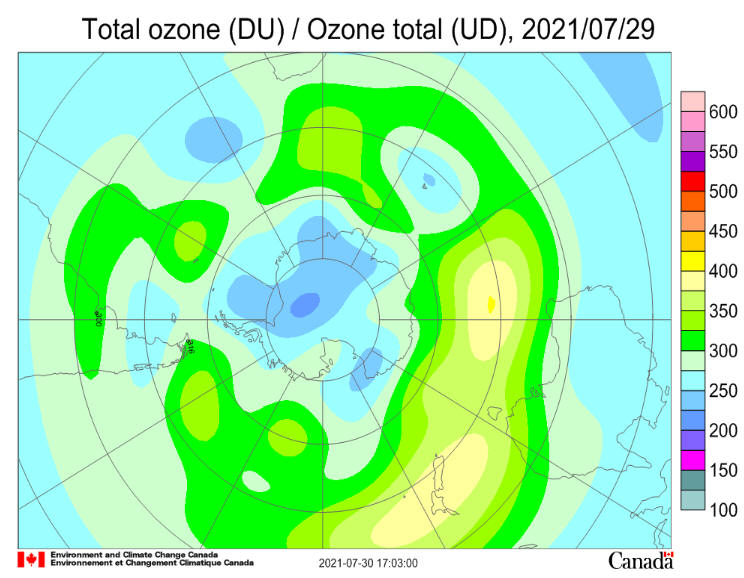
Antarctic Situation at 2021 June 25
British
Antarctic Survey Ozone Bulletin
Antarctic ozone today: The 2021 southern polar vortex is building, so
that higher ozone values, up to 340 DU are seen around the continent. The
stratosphere is currently very stable. Ozone amounts over the continent
are still near the autumn minimum, around 250 DU and are relatively
uniform, however ozone depletion is beginning to take place. The
temperature of the ozone layer over Antarctica is falling and is below
the -78°C Polar Stratospheric Cloud (PSC) formation threshold. The area
with PSCs is 20 million square kilometres (msqkm), a little above average
for the time of year. The ozone layer temperature is highest around
Antarctica and declines towards the equator and towards the centre of the
polar vortex. The vortex has grown to 25 msqkm, about average for the
time of year.
The Ozone Hole August 2021
The Ozone Hole September 2021
The Ozone Hole October 2021
The Ozone Hole November 2021
|
















